India’s agro-industrial sector in 2025 stands as one of the country’s most dynamic and transformative industries. From food processing and dairy to agri-tech and bio-based manufacturing, agro industries are reshaping rural economies and strengthening India’s position as a global agricultural powerhouse.

Overview: The Backbone of Rural Growth
Agro industries — enterprises that process agricultural products and add value through manufacturing — are vital to India’s economic and social fabric. Contributing nearly 17–18% to India’s GDP (through agriculture and allied activities) and supporting over 40% of the workforce, this sector acts as a bridge between farms and markets.
By 2025, India’s agro-industrial ecosystem has evolved into a multi-billion-dollar domain. Market analysts estimate that the Indian food processing industry alone is valued at around USD 600 billion, with growth driven by rising domestic demand, export opportunities, and supportive government policies. Allied agro-based sectors such as dairy, meat processing, sugar, edible oils, and agri-biotechnology are also expanding rapidly, reflecting a nationwide shift toward value addition and sustainable production.
Policy Push and Government Initiatives
Government intervention has been a decisive factor in the sector’s transformation. Policies such as “Make in India,” “Doubling Farmers’ Income,” and “Atmanirbhar Bharat” have emphasized rural industrialization and agri-based entrepreneurship.
Key initiatives influencing 2025’s landscape include:
- Production-Linked Incentive (PLI) Scheme for Food Processing: Encourages domestic manufacturing and global competitiveness in processed foods.
- Pradhan Mantri Kisan Sampada Yojana (PMKSY): Supports mega food parks, cold chain logistics, and modern processing facilities.
- Agriculture Infrastructure Fund (AIF): Offers low-interest financing for warehouses, primary processing units, and supply chain modernization.
- Digital Agriculture Mission 2025: Promotes the use of AI, drones, IoT, and data analytics for precision farming and agro-logistics.
Together, these schemes have created an enabling environment for agro industries to scale, innovate, and integrate with global markets.
Emerging Segments Within Agro Industries
The Indian agro-industrial sector in 2025 is marked by diversification. Major growth segments include:
- Food Processing: India ranks among the world’s top producers of grains, fruits, vegetables, and dairy. Companies like ITC, Amul, Parle Agro, and Patanjali are investing heavily in processing infrastructure and branding for domestic and export markets.
- Agri-Tech and Farm Mechanization: Startups and large corporations are introducing smart irrigation, drone-based crop monitoring, and precision seeding technologies. Agri-tech investments in India surpassed USD 1 billion by 2024, setting the stage for smarter and more efficient supply chains.
- Bio-based Industries: The rise of bio-fertilizers, biofuels, and biodegradable packaging derived from agricultural residues reflects India’s move toward sustainability and circular economy practices.
- Cold Chain and Logistics: With greater emphasis on reducing post-harvest losses, cold storage capacity has seen exponential growth, aided by both government and private investment.
Export Potential and Global Integration
India’s agro exports have witnessed steady growth, reaching over USD 53 billion in FY2024, and are projected to cross USD 60 billion in FY2025. Processed foods, spices, marine products, rice, and organic produce dominate export baskets.
India’s improved compliance with international quality standards, coupled with trade partnerships across the Middle East, Europe, and Africa, has enhanced its competitiveness. The “Brand India” initiative under the Agricultural and Processed Food Products Export Development Authority (APEDA) has been instrumental in marketing Indian agro products globally.
Challenges and Roadblocks
Despite the optimism, agro industries continue to face systemic challenges:
- Fragmented supply chains and small-scale operations limit efficiency.
- Inadequate rural infrastructure, especially cold storage and transportation.
- Climate change impacts yields and raw material availability.
- Credit access and financing gaps for small agro-entrepreneurs.
- Skill shortages in processing technology and quality management.
Addressing these issues requires stronger public-private collaboration, focused R&D investment, and digital inclusion across rural regions.
Opportunities for 2025 and Beyond
The future of India’s agro industries lies in innovation, sustainability, and inclusivity. Key opportunities include:
- Value chain integration: Linking farmers directly with processors and exporters through digital marketplaces.
- Sustainable agriculture: Expanding organic farming and eco-friendly inputs.
- Rural entrepreneurship: Encouraging micro-processing units and FPO-led clusters.
- Agro-tourism and local branding: Leveraging regional specialties for niche consumer markets.
With rising consumer awareness, domestic brands are focusing on transparency, traceability, and eco-packaging — trends that align with global sustainability standards.
The Road Ahead
By the end of 2025, India’s agro-industrial base is stronger, more diversified, and technologically empowered. It is moving from being a producer of raw commodities to a value-added manufacturing hub that can compete globally.
The synergy between farmers, entrepreneurs, policymakers, and investors will determine how far this transformation goes. If India continues to invest in technology, infrastructure, and sustainable practices, the agro industry could contribute over USD 700–800 billion to the economy by 2030, positioning India not just as a food basket — but as an agro-industrial leader of the future.

